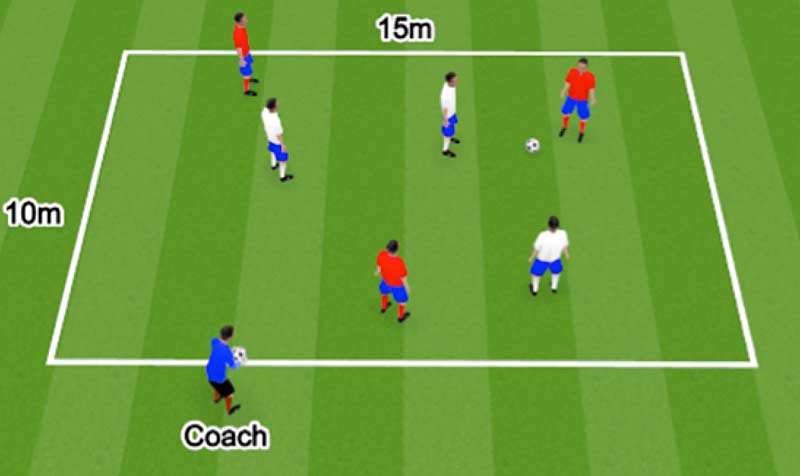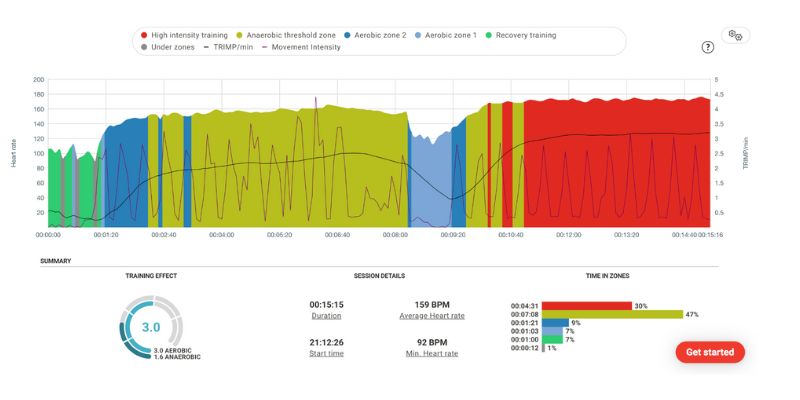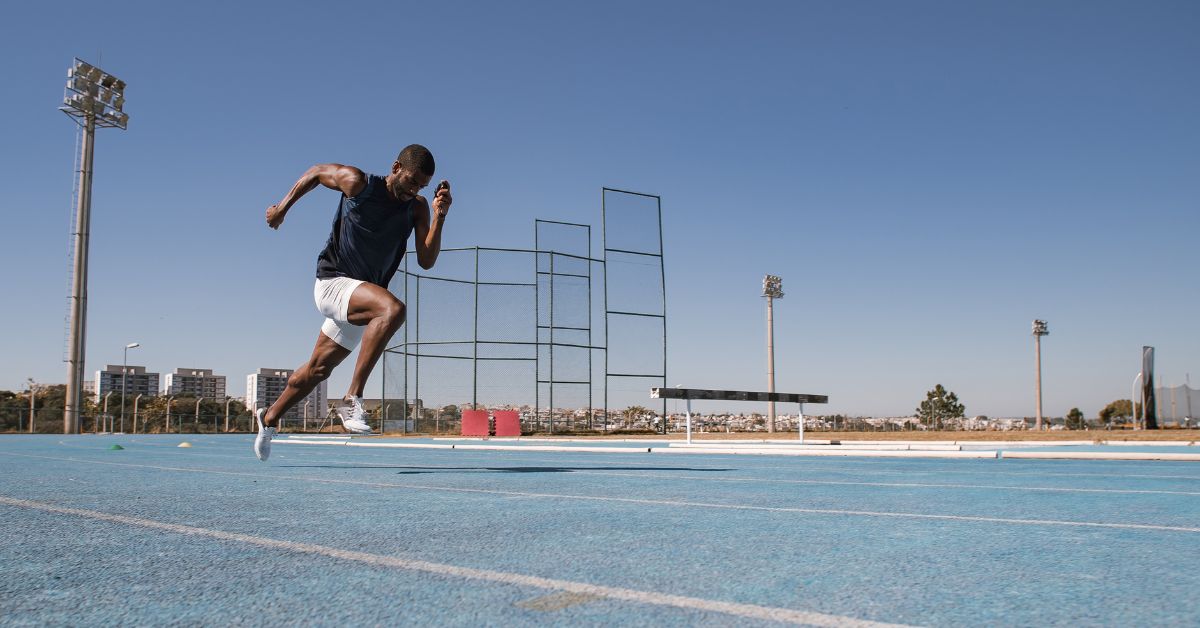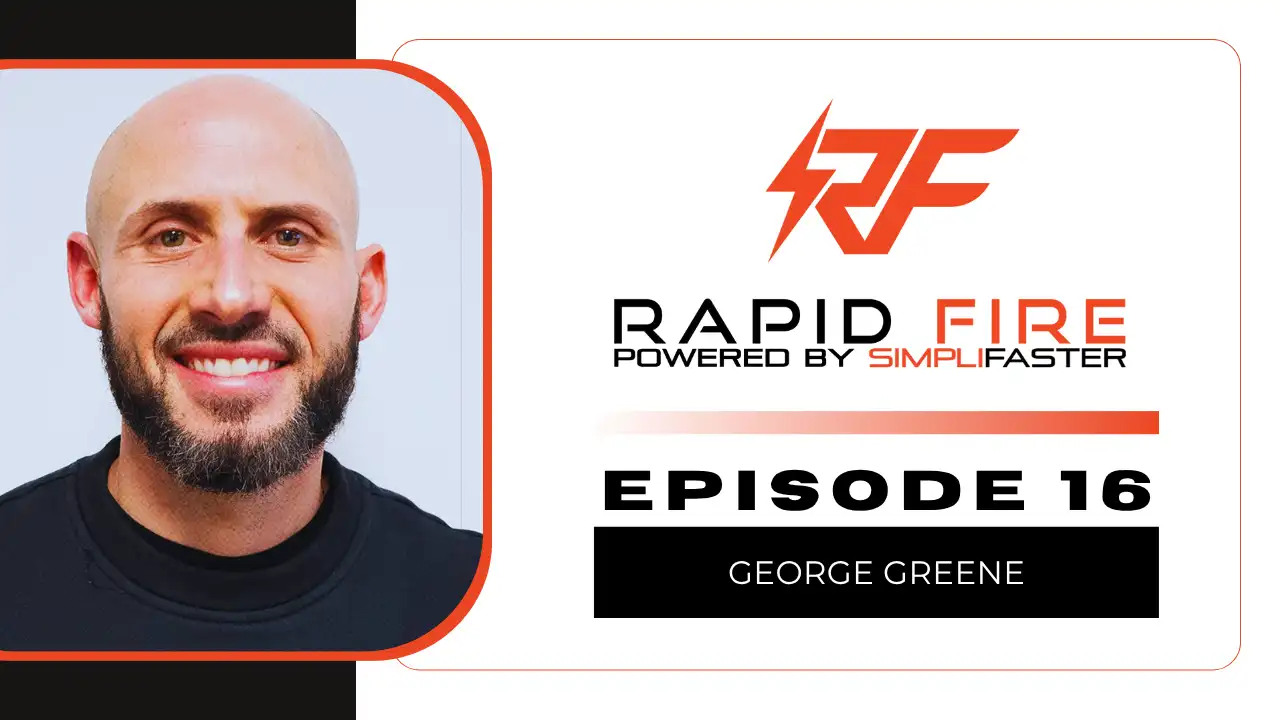In-season, immediate sports performance is the primary goal; thus, proper stress management is crucial. Given the heavy game schedule in team sports, coaches need to find ways to optimize the time efficiency of concurrent training by combining different stimuli. Small-sided games (SSGs) are often used to improve motivation, sport-specific movement efficiency, tactical awareness, and technical skills. The intensity of exercise SSGs can be modulated by manipulating variables such as field dimensions, player numbers, technical rules, coach encouragement, and the type of exercise regime (continuous vs. intermittent), making them an effective method for improving metabolic conditioning via inducing aerobic, anaerobic, and neuromuscular adaptations in a time-efficient manner.
While all metabolic conditioning ideally should be done through playing and practicing the sport, as it’s challenging to replicate the physical and emotional stress produced by the sport, it’s crucial to recognize the potential drawbacks of small-sided games as a tool for improving metabolic conditioning such as:
- It is difficult to precisely standardize the overall load of SSGs due to the variability of responses within players. This variability can lead to differences in cardiovascular responses and neuromuscular responses as well as inconsistent blood lactate.
- Data shows that the average oxygen consumption (VO2) is inversely related to VO2max during SSG, suggesting a possible ceiling effect for VO2max development in fitter players.
- While being enormously flexible, SSGs may not always be highly specific to competitive games.
- Overexposure to high-intensity competitive drills during SSGs may increase athletes’ risk of acute injuries.

Figure 1. Visual representation of SSG in soccer, figure via Ryan Cotter’s article “Training Your Substitutes in Soccer.“
It is important to note that besides SSGs, responses among players during actual games are significantly variable. Scientific literature establishes that factors such as playing time, position, competition level, and playing style, among other elements, affect the players’ external and internal load.
While all metabolic conditioning ideally should be done through playing and practicing the sport, it’s crucial to recognize the potential drawbacks of small-sided games for improving metabolic conditioning. Share on XNon-specific conditioning methods do not substitute for small-sided games (SSGs) and the actual game, but rather complement them as individualized tools that provide a controlled environment for developing metabolic conditioning while objectively measuring progress.
It is worth noting that different conditioning methods fall across the intensity spectrum from low to high, depending on the overall load on the body. More volume is generally needed to achieve training adaptations and improve conditioning when intensity is lower.
While there are various methods of metabolic conditioning, discussing and analyzing each one is beyond the scope of this article. This article is all about understanding the role of HIIT training as a non-specific conditioning method in-season.
HIIT Training: What? Why? How?
Before I begin writing this section, I want to highlight the book Science and Application of High-Intensity Interval Training. This book is an invaluable resource, and much of the information presented in the following paragraphs is derived from it.
HIIT variables can all be manipulated to modify the physiological load (aerobic, anaerobic, neuromuscular), says Konstantinos Stratakis. Share on XAll the chapters in this magnificent book are genuinely outstanding. That being said, I loved chapters 3-5 the most. The authors do an excellent job describing in detail the physiological targets of HIIT, explaining the HIIT variables and ways to manipulate them according to the desired outcome while smoothly transitioning to the actual utilization of the different HIIT formats.
Now that we’ve addressed that, let’s begin: HIIT training is defined as the repeated performance of relatively short intervals of high-intensity work interspersed with low-intensity work or rest intervals, where full recovery is usually not allowed. HIIT has gained popularity due to its ability to positively impact both the aerobic and anaerobic systems while inducing neuromuscular adaptations in a time-efficient manner.
Nine HIIT variables, including work intensity, work duration, recovery interval intensity, recovery interval duration, exercise modality, number of intervals, number of series, between-series recovery duration, and between-series recovery intensity, can all be manipulated to modify the physiological load (aerobic, anaerobic, neuromuscular).
In HIIT, there are two types of load intensity indicators: external and internal. External intensity load indicators include running speed at VO2max (vVO2max or MAS), maximum sprinting speed (MSS), anaerobic speed reserve (ASR = MSS – MAS), and VIFT (achieved speed in the intermittent fitness test 30-15) for running and power output at VO2max (PVO2max) and maximum power output (Pmax) for rowing and bicycle-ergometer. On the other hand, the most commonly used internal intensity load indicators in the practical field include heart rate (% of HRmax), level of perceived exertion (RPE), and blood lactate accumulation.
According to the authors of the book Science and Application of High-Intensity Interval Training there are four HIIT formats:
1. HIIT Long
Work intensity:
- 90-105% vVO2max (MAS)
Work duration:
- 1-2 min to a maximum of 5-6 min
Relief interval duration and intensity:
- Shorter passive
- Longer active, but with a lower load intensity (40-50% vVO2max)
Example:
- (5-8 x 3 min [95% MAS], r= 4-5 min [50% vVO2max] or r= 2-3 min passive)
2. HIIT Short
Work intensity:
- 100-130% vVO2max (MAS)
Work duration:
- 15-60 sec
Relief interval duration and intensity:
- Passive for higher work/rest ratios and work intensities
- Active (50-60% vVO2max) for lower work/rest ratios and work intensities
Example:
- 2-3x (8 x 30 sec [110% vVO2max], r= 30 sec [50% vVO2max] or r= 15 sec passive)
[vimeo 1014135582 w=800]
Video 1. A player performing a repetition of HIIT repeated sprint interval..
3. Repeated Sprint Training
Work intensity:
- Maximum (85-100% of MSS)
Work duration:
- 3-8 sec
Relief interval duration and intensity:
- 3-5 times more than work duration passive
- 5-8 times more than work duration active (50-60% vVO2max)
Example:
- 2-4 x (6-10 x 3-6 sec max, r= 15-20 sec passive or r= 20-30 sec active)
[vimeo 1014136305 w=800]
Video 2. A player performing a repetition of HIIT short interval.
4. Sprint Interval Training
Work intensity:
- Maximum
Work duration:
- 15-45 sec
Relief interval duration and intensity:
- 2-4 min, passive
Example:
- 1 x (4-8 x 20-40 sec max, r= 2-4 min passive)
When using different HIIT formats, it’s essential to consider the specificity continuum of exercise modalities. More specific exercise modalities, such as patterned running, are great for simulating the demands of the sport. In contrast, more general modalities, like biking, are better for inducing central adaptations without overloading specific structures. In my practice, particularly during the in-season, I typically use specific exercise methods most of the time. However, there are certain situations where I might use more general exercise methods, such as during long HIIT sessions or when I want to reduce strain on the neuromuscular system. I will delve into this further in later sections of this article.
Training time above 90% of VO2max has been established as a good criterion for judging the effectiveness of a training program to improve aerobic fitness, says Konstantinos Stratakis. Share on XThe videos above provide examples of exercise modalities specific to basketball. In the first clip, the player performs a repetition of a HIIT short interval. In the second clip, the player does a repeated sprint interval. It is important to note that the player’s skill level should not be a limiting factor. Therefore, familiar movement patterns are preferred.
HIIT Training and Aerobic, Anaerobic, and Neuromuscular Contribution
The various HIIT formats uniquely affect the aerobic, anaerobic, and neuromuscular systems. As mentioned earlier in this article, adjusting the nine different HIIT variables allows for modifying the overall physiological load.
1. HIIT Training and Aerobic Contribution
An increase in VO2 max positively relates to training intensity in the 50-100% VO2max range. Several reviews have supported the superior efficacy of training at near VO2max. More precisely, training time above 90% of VO2max has been established as a good criterion for judging the effectiveness of a training program to improve aerobic fitness.
Both HIIT short and long seem to be very effective training methods for accumulating time above 90% of VO2max. When it comes to repeated sprint intervals, 4 seconds of work, including jumps and COD, and 20 seconds of active rest is going to maximize time above 90% of VO2max, even if this training method is not optimal for this purpose. Even if there is a high demand for muscle oxygenation, sprint interval training hardly maximizes time above 90% of VO2max. That said, the higher the session volume, the more the aerobic system contributes to energy production.
2. HIIT Training and Anaerobic Contribution
Occasionally, coaches prefer to limit the anaerobic contribution of specific HIIT sessions to lower the overall RPE or avoid depletion of glycogen stores while accumulating higher volumes of near VO2max training.
The use of blood lactate concentration to assess anaerobic glycolytic energy contribution has several limitations (nutritional status, aerobic fitness, timing, etc.). However, it is still the most reliable method for assessing anaerobic contribution during HIIT.
Long HIIT intervals are less flexible overall. Higher work intensities, longer work interval durations, and shorter rest intervals are all closely related to a higher rate of blood lactate increase. When the rest interval duration is more prolonged, active recovery can accelerate blood lactate clearance.
Short intervals, on the other hand, are generally more flexible. Short HIIT sessions with similar mean intensity but higher work interval intensities elicit more significant blood lactate responses. Increases in the work/rest ratio and work interval durations are associated with increases in the initial rate of blood lactate accumulation. With increased recovery intensities, a progressive increase in blood lactate is observed at exhaustion.
The initial rate of blood lactate accumulation during repeated sprint intervals is primarily correlated with its work/rest ratio. Sprints longer than 4 seconds and relief intervals less than 20 seconds and active elicit more blood lactate accumulation. Greater COD angles may increase muscle recruitment, but absolute sprinting speed is lower, which results in less lactate accumulation.
Regarding sprint interval training, shorter sprints and/or lower intensities will lower the anaerobic glycolytic energy contribution. That said, more than 45-second sprints engage a more significant contribution from the aerobic system. For more lactate production, recovery periods should be long enough to allow the aerobic system to return to its resting levels while avoiding over-acidic status.
3. HIIT Training and Neuromuscular Contribution
Managing neuromuscular load during HIIT training is essential because it:
- Affects time at VO2max.
- Might have potential carry-over effects for subsequent training sessions.
- Might modulate long-term neuromuscular adaptations.
- May influence injury risk (traumatic and overuse).
While the majority of muscle fibers might already be recruited during long intervals, the firing rate and relative force development per fiber are likely greater during short intervals. Long and short intervals with more anaerobic contribution might equal more fatigue. For “bigger” athletes, the musculoskeletal load of long intervals might be higher than during short intervals due to poor running economy. Incline running and softer surfaces seem to reduce neuromuscular strain during both HIIT short and long intervals.
A lower work/relief ratio is generally associated with a more significant impairment of repeated sprinting capacity during sprint interval training. However, maintaining a higher running speed may induce a greater musculoskeletal strain. 45° COD may be an effective alternative to reducing acute neuromuscular load during RSS, with an even sharper COD being associated with a higher acute risk of both ankle and knee injuries. The high volume of decelerations has the potential to increase acute muscle fatigue.
When it comes to sprint interval training, longer rest durations show greater impairments in neuromuscular performance because they allow for max-effort bouts. Longer sprint intervals (up to 72 seconds) might have more neuromuscular demands than shorter intervals (15 seconds or 30 seconds).
The use of blood lactate concentration to assess anaerobic glycolytic energy contribution has several limitations... However, it is still the most reliable method for assessing anaerobic contribution during HIIT. Share on XAs a closer to this section, I want to mention that even if quantifying the exact physiological load of HIIT may be challenging, following the tips and tricks from the authors of Science and Application of High-Intensity Interval Training is an easy and effective way to achieve the desired results. However, due to the chaotic environment of team sports, it can be challenging to prescribe HIIT based on predetermined numbers such as ASR or MAS. Personally, I regularly use subjective (RPE) and objective (heart rate, accelerometer) measures of internal and external load to get an idea of what I get out of my HIIT sessions.
Incorporating HIIT Training as a Non-Specific Conditioning Method In-Season
I can’t hide that I am a big fan of Daniel Bove’s book The Quadrant System. This book has defined my training system. Considering this, in my system, additional non-specific conditioning always accompanies the nature of the stress related to the volume and intensity of sports practices and games. As mentioned in the book, this way, physical preparation and sport-specific training are coordinated in tandem, creating a congruent perception of stress and helping to avoid flatlining.
For example, game days are accompanied by conditioning protocols such as HIIT short protocols, which place high stress on the aerobic, anaerobic, and neuromuscular systems. The overall volume of the conditioning sessions depends on various factors, including the acute/chronic load, the psychophysiological status and age of players, the availability of resources, etc.
Generally, high-minute players do not undergo extra conditioning unless there is an overreaching phase. However, moderate and low/no-minute players have additional conditioning sessions, with the overall session volume varying based on the need analysis process, as already mentioned.
Regarding sports practices, higher-intensity, lower-volume practices are usually combined with conditioning protocols that place high stress on the neuromuscular and anaerobic systems and moderate/low stress on the aerobic system. This can include repeated sprint intervals or HIIT short with lower density but higher outputs.
Lower intensity, higher volume sports practices, on the other hand, are most often paired with tempo intervals or even LISS training. Hopefully, another article will provide more information on these protocols.
The most challenging practices of the week, which involve both high volume and high intensity, are more commonly paired with HIIT short or, less often, HIIT long intervals, thereby stressing all systems (aerobic, anaerobic, neuromuscular). Rarely, I might program very low-volume sprint interval training to challenge athletes mentally and physically.
Overall, non-specific conditioning should support and complement specific training, or in other words, the sport itself. Too much allostatic load at the wrong time can be detrimental to both performance and development. Thus, it is crucial to intelligently combine HIIT training with the sport’s stressors while adjusting its overall volume according to each athlete’s status.
More precisely, the likely acute neuromuscular impact of different training formats may play a critical role in the neuromuscular adaptations and interferences that develop from supplementary training and match content.
In addition to looking at the neuromuscular load as a general term, it’s important to consider the specific effects of HIIT on different muscle groups. For example, when organizing a tactical session that involves a lot of high-speed running (HSR), it’s advisable to avoid putting too much strain on the hamstrings. However, if the aim is to specifically work those muscle groups, for example to prepare for the high demands of a match, a HIIT sequence focused on high-speed running could be included in the program.
This year, I have the opportunity to work with Firstbeat technology. Firstbeat provides me with insights into the players’ external factors (such as movement load) and internal load (like TRIMP) in real-time. This enables me to make well-informed decisions about programming additional non-specific conditioning, including HIIT. Firstbeat also provides me with real-time feedback on the aerobic and anaerobic demands during sports practices and non-specific conditioning sessions, allowing me to adjust HIIT variables (Figure 2).

A Thing to Consider When Programming HIIT
One aspect that has not been given much attention is that, for most high-intensity interval training options, the average movement intensity (movement load per minute, density) tends to be much higher than the peak match demands for similar durations.
For example, certain HIIT short protocols enable athletes to cover the same high-speed running (HSR) distance as a 90-minute match in less than 15 minutes. This principle applies to other vital metrics in different sports, such as high-intensity accelerations/decelerations in basketball and high-intensity jumps in volleyball.
This means that HIIT can easily overwhelm the average movement intensity for a given metric during a match. The question is: “How much does this matter regarding fitness development, match preparation, and injury management?”
It might be reasonable to assume that such extreme overload is unnecessary and should be avoided. Breaking the HIIT sequences into smaller effort sequences, followed by rest periods, may reduce the average movement intensity of a certain metric closer to the actual game demands.
HIIT can easily overwhelm the average movement intensity for a given metric during a match. The question is: How much does this matter regarding fitness development, match preparation, and injury management? Share on XHowever, this may not be sufficient to enable the desired adaptations in cardiorespiratory response. Coaches may need to decide whether to prioritize metabolic conditioning (longer HIIT sets) or match-specific average movement intensity for a given metric (shorter HIIT sets) to achieve the desired outcomes.
In my practice, I often mix different movement patterns within the same HIIT block. For example, I alternate linear runs with multidirectional movements or jumps. This approach can help decrease the volume and average movement intensity of high-speed running (HSR), allowing players to exercise for longer periods without accumulating high volumes of a specific metric, which could lead to a sudden increase in workload.
Final Thoughts
In a perfect world, all conditioning should be completed by playing and practicing the sport. Even if it’s challenging to replicate the physical and emotional stress produced by the sport itself, there are times when non-specific metabolic conditioning is necessary.
HIIT is a powerful and highly flexible weapon for non-specific conditioning in-season. The manipulation of the different HIIT variables allows coaches to adjust the physiological load. In my system, additional non-specific conditioning always accompanies the nature of the stress related to the volume and intensity of sports practices and games. When utilizing HIIT, considering the density might be worthwhile.
Since you’re here…
…we have a small favor to ask. More people are reading SimpliFaster than ever, and each week we bring you compelling content from coaches, sport scientists, and physiotherapists who are devoted to building better athletes. Please take a moment to share the articles on social media, engage the authors with questions and comments below, and link to articles when appropriate if you have a blog or participate on forums of related topics. — SF





